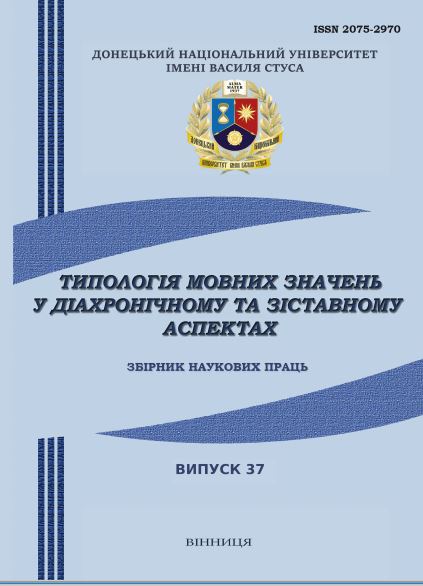Semantic Structure of the Nouns Denoting Good in Ukrainian and English.
DOI:
https://doi.org/10.31558/2075-2970.2019.37.2Keywords:
formalized analysis of lexical semantics. lexico-semantic group, matrix, seme stock, qualitative and quantitative characteristicsAbstract
The article deals with the comparative study of the semantic structure of the lexis denoting good in modern Ukrainian and English with the help of lexical semantics formalized analysis. It allowed to arrange the register of the words denoting good in two distantly related languages on the basis of the thorough analysis of the most authoritative explanatory dictionaries; model their lexicosemantic groups; construct the matrices presenting correlations between the words and their meanings; disclose quantitative and qualitative characteristics of the semantic structure of the nouns denoting good; compare the seme stocks of the lexico-semantic groups in modern Ukrainian and English.
A complex semantic analysis of the lexical units denoting good in the languages under research on the basis of matrix method revealed the hierarchical order and organization of semes in their lexical meanings. The seme stock is devided into six subsets which represent a wide range of the nouns’ semantics.
According to the frequency of their occurrence in the meanings of the words denoting good the semes may be polyfunctional, with middle degree of functionality, and monofunctional ones.
References
Bilodid, I. K. (1970–1980). Slovnyk ukrajinsjkoji movy. Kyjiv : Naukova dumka, 1–11.
Cruse, A. (2000). Meaning in Language. An Introduction to Semantics and Pragmatics. New York: Oxford University Press.
Danesi, M. (2016). Language and Mathematics: An Interdisciplinary Guide. Boston–Berlin: Mouton de Gruyter.
Fabian, M. P. (1998). Etyketna leksyka v ukrajinsjkij, anghlijsjkij ta ughorsjkij movakh. Uzhghorod: Informacijno-vydavnyche aghentstvo “IVA”.
Goddard, C., Wiezbicka, A. (2014). Words and Meanings. Lexical Semantics across Domains, Languages and Cultures. UK: Oxford Uniersity Press.
Kocherghan, M. P. (2006). Osnovy zistavnogho movoznavstva. Kyjiv: Akademija.
Murray, J. (1963). Oxford English Dictionary. London: Oxford University Press, 1–12.
Onyshhak, Gh.V. (2019). Systemno-strukturna parametryzacija leksyko-semantychnoji ghrupy “Zlo” v ukrajinsjkij, anghlijsjkij ta francuzjkij movakh (dys. na zdobuttja nauk. stup. kand. filol. nauk). Kyjivsjkyj nacionaljnyj linghvistychnyj universytet, Kyjiv.
Ortiz, A., Zierer, E. (1968). Set theory and linguistics. The Hague / Paris, Mouton.
Shhapaceva, M. H., Pazova, L. M. (2014). znachenii slova. Vestnik Adygejskogo gosudarstvennogo universiteta, 1, 121–127.

